Volgograd
Volgograd (Russian: Волгогра́д), formerly Tsaritsyn (Цари́цын) (1589–1925), and Stalingrad (Сталингра́д) (1925–1961), is the largest city and the administrative centre of Volgograd Oblast, Russia. The city lies on the western bank of the Volga, covering an area of 859.4 square kilometres (331.8 square miles), with a population of over 1 million residents.[11] Volgograd is the fifteenth-largest city in Russia, the second-largest city on the Southern Federal District, and the fourth-largest city on the Volga.
Volgograd
Волгоград | |
|---|---|
City[1] | |
 Counterclockwise: The Motherland Calls on Mamayev Kurgan, the railway station, Planetarium, The Metrotram, Panorama of the City, Gerhardt Mill | |
 Flag  Coat of arms | |
| Anthem: none[2] | |
Location of Volgograd 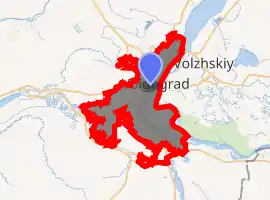
| |
 Volgograd Location of Volgograd .svg.png.webp) Volgograd Volgograd (European Russia) 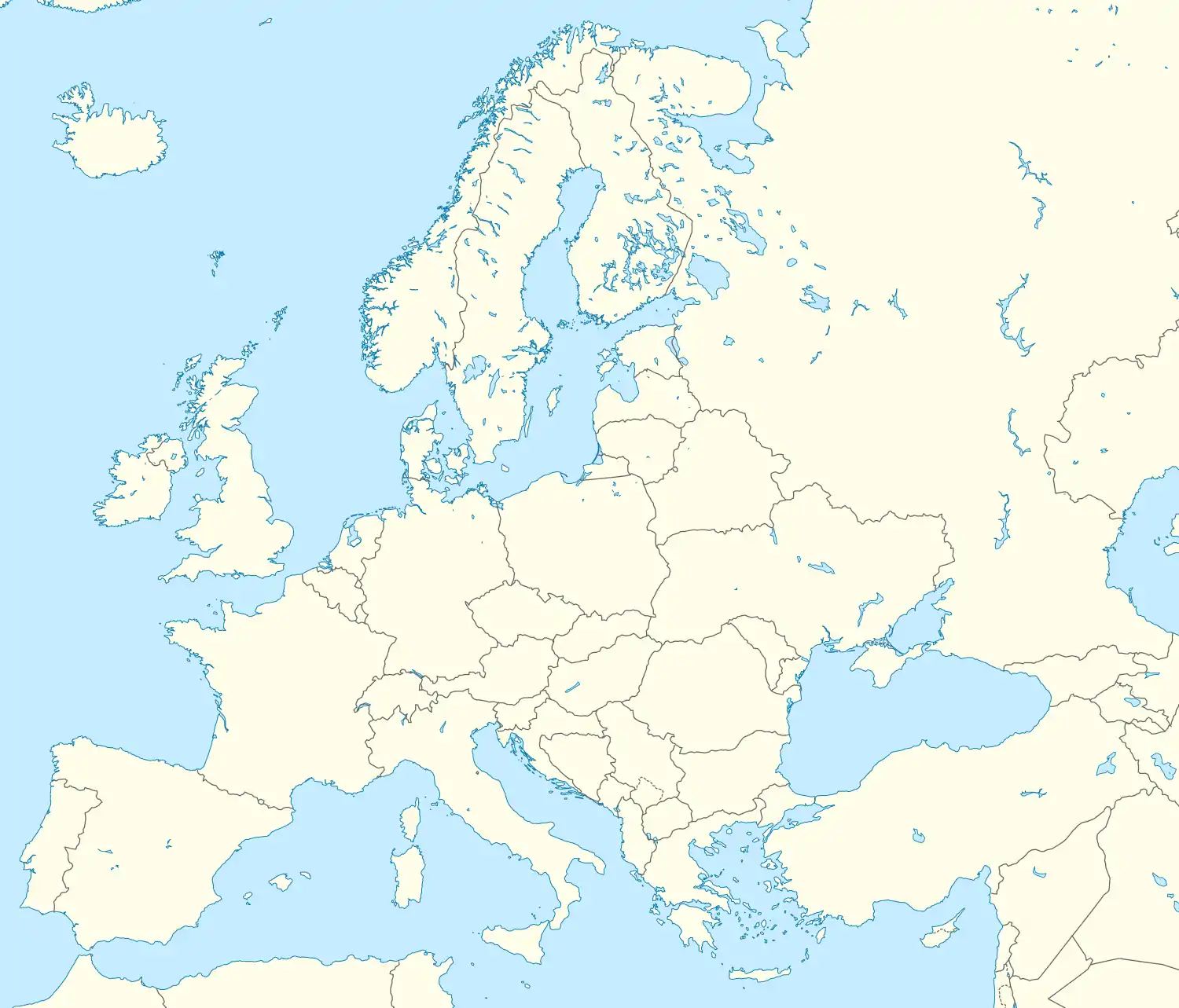 Volgograd Volgograd (Europe) | |
| Coordinates: 48°42′N 44°31′E | |
| Country | Russia |
| Federal subject | Volgograd Oblast[3] |
| Founded | 1589[4] |
| City status since | the end of the 18th century[1] |
| Government | |
| • Body | City Duma[5] |
| • Head[5] | Alexander Chunakov |
| Elevation | 80 m (260 ft) |
| Population | |
| • Total | 1,021,215 |
| • Estimate (2018)[7] | 1,013,533 (−0.8%) |
| • Rank | 12th in 2010 |
| • Subordinated to | city of oblast significance of Volgograd[3] |
| • Capital of | Volgograd Oblast[3], city of oblast significance of Volgograd[3] |
| • Urban okrug | Volgograd Urban Okrug[8] |
| • Capital of | Volgograd Urban Okrug[8] |
| Time zone | UTC+4 (MSK+1 |
| Postal code(s)[10] | 400000–400002, 400005–400012, 400015–400017, 400019–400023, 400026, 400029, 400031–400034, 400036, 400038–400040, 400042, 400046, 400048–400055, 400057–400059, 400062–400067, 400069, 400071–400076, 400078–400082, 400084, 400086–400089, 400093, 400094, 400096–400098, 400105, 400107, 400108, 400110–400112, 400117, 400119–400125, 400127, 400131, 400136–400138, 400700, 400880, 400890, 400899, 400921–400942, 400960–400965, 400967, 400970–400979, 400990–400993 |
| Dialing code(s) | +7 8442 |
| OKTMO ID | 18701000001 |
| City Day | Second Sunday of September[1] |
| Website | www |
The city was founded as the fortress of Tsaritsyn in 1589. By the nineteenth century, Tsaritsyn became an important river-port and commercial centre, leading to its population expanding rapidly. During the Russian Civil War, Tsaritsyn came under Soviet control. On April 10, 1925, the city was renamed Stalingrad in honor of Joseph Stalin. During World War II, the Axis forces attacked the city, leading to the Battle of Stalingrad, one of the largest and bloodiest battles in the history of warfare. On 10 November 1961, Nikita Khrushchev's administration changed the name of the city to Volgograd. After the dissolution of the Soviet Union, the city became the administrative centre of Volgograd Oblast.
Known locally as the "Hero City", Volgograd today is the site of The Motherland Calls, an 85-meter high statue dedicated to the heroes of the battle, which is the tallest statue in Europe, as well as the tallest statue of a woman in the world. The city has many tourist attractions, such as museums, sandy beaches, and a self-propelled floating church. Volgograd was one of the host cities of the 2018 FIFA World Cup.
History
Tsaritsyn
_(1857).png.webp)

.jpg.webp)
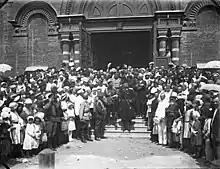
Although the city may have originated in 1555, documented evidence of Tsaritsyn at the confluence of the Tsaritsa and Volga rivers dates from 1589.[4] Grigori Zasekin established the fortress Sary Su (the local Tatar-language name means "yellow water" or "yellow river") as part of the defenses of the unstable southern border of the Tsardom of Russia. The structure stood slightly above the mouth of the Tsaritsa River on the right bank. It soon became the nucleus of a trading settlement.
At the beginning of the 17th century, the garrison consisted of 350 to 400 people. In 1607 the fortress garrison rebelled for six months against the troops of Tsar Vasili Shuisky. In 1608 the first stone church was built in the city and was dedicated to St. John the Baptist.
In 1670 troops of Stepan Razin captured the fortress; they left after a month. In 1708 the insurgent Cossack Kondraty Bulavin (died July 1708) held the fortress. In 1717 in the Kuban pogrom, raiders from the Kuban under the command of the Crimean Tatar Bakhti Gerai blockaded the town and enslaved thousands in the area. In August 1774 Yemelyan Pugachev unsuccessfully attempted to storm the city.
In 1691 Moscow established a customs-post at Tsaritsyn. In 1708 Tsaritsyn was assigned to the Kazan Governorate; in 1719 to the Astrakhan Governorate. According to the census in 1720, the city had a population of 408 people. In 1773 the settlement was designated as a provincial and district town. From 1779 it belonged to the Saratov Viceroyalty. In 1780 the city came under the newly established Saratov Governorate.
In the nineteenth century, Tsaritsyn became an important river-port and commercial center. The population expanded rapidly, increasing from fewer than 3,000 people in 1807 to about 84,000 in 1900. The first railway reached the town in 1862. The first theatre opened in 1872, the first cinema in 1907. In 1913 Tsaritsyn got its first tram-line, and the city's first electric lights were installed in the city center.
During the Russian Civil War of 1917–1923, Tsaritsyn came under Soviet control from November 1917. In 1918 White Movement troops under Pyotr Krasnov, the Ataman of the Don Cossack Host, besieged Tsaritsyn. The Reds repulsed three assaults by the Whites. However, in June 1919 the White Armed Forces of South Russia, under the command of General Denikin, captured Tsaritsyn, and held it until January 1920. The fighting from July 1918 to January 1920 became known as the Battle for Tsaritsyn.
Stalingrad
On April 10, 1925, the city was renamed Stalingrad, in honor of Joseph Stalin, General Secretary of the Communist Party.[12][13] This was officially to recognize the city and Stalin's role in its defense against the Whites between 1918 and 1920.[14] In 1931, the German settlement-colony Old Sarepta (founded in 1765) became a district of Stalingrad. Renamed Krasnoarmeysky Rayon (or "Red Army District"), it was the largest area of the city.
The first higher education institute was opened in 1930. A year later, the Stalingrad Industrial Pedagogical Institute, now Volgograd State Pedagogical University, was opened. Under Stalin, the city became a center of heavy industry and transshipment by rail and river.
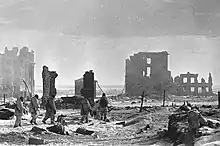
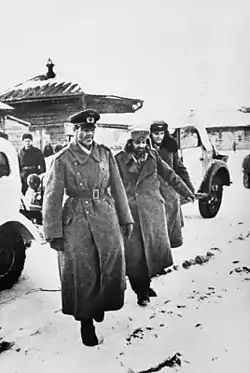
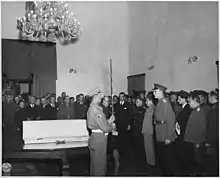
Battle of Stalingrad
During World War II, German and Axis forces attacked the city, and in 1942 it was the site of one of the pivotal battles of the war. The Battle of Stalingrad was the deadliest single battle in the history of warfare (estimates vary between 1,250,000[15] and 1,798,619[16]).
The battle began on August 23, 1942, and on the same day, the city suffered heavy aerial bombardment that reduced most of it to rubble. Martial law had already been declared in the city on July 14. By September, the fighting reached the city center. The fighting was of unprecedented intensity; the city's central railway station changed hands thirteen times, and the Mamayev Kurgan (one of the highest points of the city) was captured and recaptured eight times.
By early November, the German forces controlled 90 percent of the city and had cornered the Soviets in two narrow pockets, but they were unable to eliminate the last pockets of Soviet resistance before Soviet forces launched a huge counterattack on November 19. This resulted in the Soviet encirclement of the German Sixth Army and other Axis units. On January 31, 1943 the Sixth Army's commander, Field Marshal Friedrich Paulus, surrendered, and by February 2, with the elimination of straggling German troops, the Battle of Stalingrad was over.
In 1945 the Soviet Union awarded Stalingrad the title Hero City for its resistance. Great Britain's King George VI awarded the citizens of Stalingrad the jeweled "Sword of Stalingrad" in recognition of their bravery.
A number of cities around the world (especially those that had suffered similar wartime devastation) established sister, friendship, and twinning links (see list below) in the spirit of solidarity or reconciliation. One of the first "sister city" projects was that established during World War II between Stalingrad and Coventry in the United Kingdom; both had suffered extensive devastation from aerial bombardment.
Volgograd

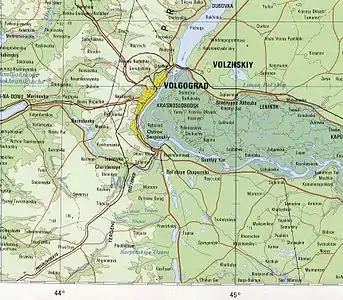
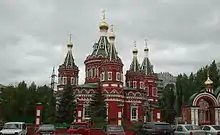

On 10 November 1961, Nikita Khrushchev's administration changed the name of the city to Volgograd ("Volga City") as part of his programme of de-Stalinization following Stalin's death. He was trying to reduce the "cult of personality". This action was and remains somewhat controversial, because Stalingrad has such importance as a symbol of resistance during World War II.
During Konstantin Chernenko's brief administration in 1984, proposals were floated to revive the city's historic name for that reason. There is a strong degree of local support for a reversion, but the Russian government has not accepted such proposals.
On May 21, 2007, Roman Grebennikov of Communist Party was elected as mayor with 32.47% of the vote, a plurality. Grebennikov became Russia's youngest mayor of a federal subject administrative center at the time.
In 2010, Russian monarchists and leaders of the Orthodox organizations demanded that the city should take back its original name of Tsaritsyn, but the authorities rejected their proposal.
On January 30, 2013, the Volgograd City Council passed a measure to use the title "Hero City Stalingrad" in city statements on nine specific dates annually.[17][18][19] On the following dates the title "Hero City Stalingrad" can officially be used in celebrations:
- February 2 (end of the Battle of Stalingrad),
- February 23 (Defender of the Fatherland Day),
- May 9 (Victory Day),
- June 22 (start of Operation Barbarossa),
- August 23 (start of the Battle of Stalingrad),
- September 2 (Victory over Japan Day),
- November 19 (start of Operation Uranus),
- December 9 (Day of the Fatherland's Heroes)[17]
In addition, 50,000 people signed a petition to Vladimir Putin, asking that the city's name be permanently changed to Stalingrad.[18] President Putin has replied that such a move should be preceded by a local referendum and that the Russian authorities will look into how to bring about such a referendum.[20]
Politics
In 2011, the City Duma canceled direct election of the mayor and confirmed the position of City Manager. This was short-lived, as in March 2012, Volgograd residents voted for relevant amendments to the city charter to reinstate the direct mayoral elections.[21]
Administrative and municipal status

Volgograd is the administrative center of Volgograd Oblast.[22] Within the framework of administrative divisions, it is incorporated as the city of oblast significance of Volgograd—an administrative unit with the status equal to that of the districts.[3] As a municipal division, the city of oblast significance of Volgograd is incorporated as Volgograd Urban Okrug.[8]
Economy
Modern Volgograd remains an important industrial city. Industries include shipbuilding, oil refining, steel and aluminum production, manufacture of heavy machinery and vehicles, and chemical production. The large Volgograd Hydroelectric Plant is a short distance to the north of Volgograd.
Transportation
Volgograd is a major railway junction served by the Privolzhskaya Railway. Rail links from the Volgograd railway station include Moscow; Saratov; Astrakhan; the Donbas region of Ukraine; the Caucasus and Siberia. It stands at the east end of the Volga–Don Canal, opened in 1952 to link the two great rivers of Southern Russia. European route E40, the longest European route connecting Calais in France with Ridder in Kazakhstan, passes through Volgograd. The M6 highway between Moscow and the Caspian Sea also passes through the city. The Volgograd Bridge, under construction since 1995, was inaugurated in October 2009.[23] The city river terminal is the center for local passenger shipping along the Volga River.
The Volgograd International Airport provides air links to major Russian cities as well as Antalya, Yerevan and Aktau.
Volgograd's public transport system includes a light rail service known as the Volgograd metrotram. Local public transport is provided by buses, trolleybuses and trams.
The Volga River still is a very important communication channel.
Volgograd hosts one of the few floating churches in the world: the floating church of Saint Vladimir of Volgograd.
 Trolza-5275 low-entry trolleybus
Trolza-5275 low-entry trolleybus

Climate
Volgograd has a hot-summer humid continental climate (Köppen: Dfa).[24] Despite being located further north, the city is slightly warmer than Minneapolis although only slightly (both in summer and winter, but transitional seasons are almost identical) at the same time that despite being taxed "moist" is drier than most of the climate of group D due to proximity to the Middle East and Central Asia.[25]
| Climate data for Volgograd | |||||||||||||
|---|---|---|---|---|---|---|---|---|---|---|---|---|---|
| Month | Jan | Feb | Mar | Apr | May | Jun | Jul | Aug | Sep | Oct | Nov | Dec | Year |
| Record high °C (°F) | 12.3 (54.1) |
15.8 (60.4) |
20.5 (68.9) |
29.2 (84.6) |
37.2 (99.0) |
39.4 (102.9) |
41.8 (107.2) |
42.6 (108.7) |
37.8 (100.0) |
31.0 (87.8) |
21.0 (69.8) |
12.3 (54.1) |
42.6 (108.7) |
| Average high °C (°F) | −3.3 (26.1) |
−3.1 (26.4) |
3.6 (38.5) |
14.9 (58.8) |
21.9 (71.4) |
27.0 (80.6) |
29.6 (85.3) |
28.6 (83.5) |
21.6 (70.9) |
13.0 (55.4) |
3.6 (38.5) |
−1.9 (28.6) |
13.0 (55.4) |
| Daily mean °C (°F) | −5.7 (21.7) |
−5.9 (21.4) |
.1 (32.2) |
9.9 (49.8) |
16.7 (62.1) |
21.6 (70.9) |
24.2 (75.6) |
23.0 (73.4) |
16.4 (61.5) |
8.8 (47.8) |
.8 (33.4) |
−4.2 (24.4) |
8.8 (47.8) |
| Average low °C (°F) | −9.0 (15.8) |
−9.7 (14.5) |
−3.9 (25.0) |
4.2 (39.6) |
10.1 (50.2) |
15.1 (59.2) |
17.5 (63.5) |
16.2 (61.2) |
10.4 (50.7) |
4.1 (39.4) |
−2.4 (27.7) |
−7.3 (18.9) |
3.8 (38.8) |
| Record low °C (°F) | −33.0 (−27.4) |
−32.5 (−26.5) |
−25.8 (−14.4) |
−12.8 (9.0) |
−1.1 (30.0) |
2.0 (35.6) |
7.4 (45.3) |
4.5 (40.1) |
−1.0 (30.2) |
−12.2 (10.0) |
−25.8 (−14.4) |
−27.8 (−18.0) |
−33.0 (−27.4) |
| Average precipitation mm (inches) | 38 (1.5) |
30 (1.2) |
28 (1.1) |
28 (1.1) |
39 (1.5) |
41 (1.6) |
35 (1.4) |
30 (1.2) |
29 (1.1) |
29 (1.1) |
34 (1.3) |
45 (1.8) |
406 (16.0) |
| Average snowfall cm (inches) | 11 (4.3) |
18 (7.1) |
10 (3.9) |
1 (0.4) |
trace | 0 (0) |
0 (0) |
0 (0) |
0.1 (0.0) |
1 (0.4) |
1 (0.4) |
6 (2.4) |
48.1 (18.9) |
| Average rainy days | 9 | 7 | 8 | 12 | 12 | 12 | 11 | 8 | 10 | 11 | 12 | 11 | 123 |
| Average snowy days | 20 | 18 | 11 | 2 | 0.03 | 0 | 0 | 0 | 0.1 | 1 | 9 | 18 | 79 |
| Average relative humidity (%) | 88 | 86 | 81 | 64 | 57 | 56 | 53 | 51 | 61 | 73 | 86 | 89 | 70 |
| Mean monthly sunshine hours | 66.1 | 96.9 | 138.4 | 204.2 | 290.8 | 308.4 | 329.3 | 300.2 | 228.9 | 155.8 | 63.6 | 42.5 | 2,225.1 |
| Source 1: Pogoda.ru.net[26] | |||||||||||||
| Source 2: Weatherbase (sun only)[27] | |||||||||||||
Culture
.jpg.webp)
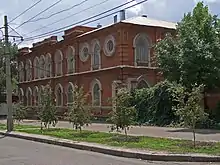
A memorial complex commemorating the battle of Stalingrad, dominated by an immense allegorical sculpture The Motherland Calls, was erected on the Mamayev Kurgan, the hill that saw some of the most intense fighting during the battle.
The Panorama Museum sited on the Volga contains artifacts from World War II. These include a panoramic painting of the battlefield from the location of the monument on Mamayev Kurgan. A rifle of the famous sniper Vasily Zaytsev is also on display.
The Musical Instrument Museum is a branch of the Volgograd regional Museum of local lore.
Education
Higher education facilities include:
- Volgograd State University
- Volgograd State Technical University (former Volgograd Polytechnical University)[28]
- Volgograd State Agriculture University
- Volgograd State Medical University[29]
- Volgograd State University of Architecture and Civil Engineering
- Volgograd Academy of Industry
- Volgograd Academy of Business Administration[30]
- Volgograd State Pedagogical University
Sports

| Club | Sport | Founded | Current League | League Tier | Stadium |
|---|---|---|---|---|---|
| Rotor Volgograd | Football | 1929 | Russian Professional Football League | 1st | Central Stadium |
| Olimpia Volgograd | Football | 1989 | Volgograd Oblast Football Championship | 5th | Olimpia Stadium |
| Kaustik Volgograd | Handball | 1929 | Handball Super League | 1st | Dynamo Sports Complex |
| Dynamo Volgograd | Handball | 1929 | Women's Handball Super League | 1st | Dynamo Sports Complex |
| Krasny Oktyabr Volgograd | Basketball | 2012 | VTB United League | 2nd | Trade Unions Sports Palace |
| Spartak Volgograd | Water Polo | 1994 | Russian Water Polo Championship | 1st | CVVS |
Volgograd was a host city to four matches of the FIFA World Cup in 2018. A new modern stadium, Volgograd Arena, was built for this occasion on the bank of the Volga River to serve as the venue. The stadium has a seating capacity for 45,000 people, including a press box, a VIP box and seats for people with limited mobility.
Notable people
- Vasily Zaytsev, Soviet sniper and a Hero of the Soviet Union
- Nikolay Davydenko, tennis player
- Sasha Filippov, spy
- Oleg Grebnev, handball player
- Yekaterina Grigoryeva, sprinter
- Larisa Ilchenko, long distance swimmer
- Yelena Isinbayeva, pole vaulter
- Lev Ivanov, association football manager
- Yuriy Kalitvintsev, association football manager
- Elem Klimov, film director
- Egor Koulechov professional basketball player
- Alexey Kravtsov, jurist
- Vladimir Kryuchkov, statesman
- Tatyana Lebedeva, jumper
- Maxim Marinin, figure skater
- Maksim Opalev, sprint canoeist
- Aleksandra Pakhmutova, composer
- Denis Pankratov, Olympic swimmer
- Evgeni Plushenko, Olympic figure skater
- Yevgeny Sadovyi, Olympic swimmer
- Natalia Shipilova, handball player
- Yelena Slesarenko, high jumper
- Leonid Slutsky, football coach
- Yuliya Sotnikova, 400m athlete
- Yulia MacLean Townsend, classical opera singer
- Igor Vasilev, handball player
- Oleg Veretennikov, association football player
- Natalia Vikhlyantseva, tennis player
International relations
Volgograd is twinned with:[31]
 Coventry, United Kingdom (1944)
Coventry, United Kingdom (1944)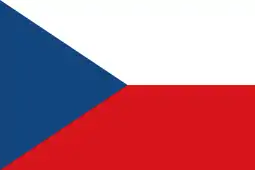 Ostrava, Czech Republic (1948)
Ostrava, Czech Republic (1948) Kemi, Finland (1953)
Kemi, Finland (1953).svg.png.webp) Liège, Belgium (1959)
Liège, Belgium (1959) Dijon, France (1959)
Dijon, France (1959)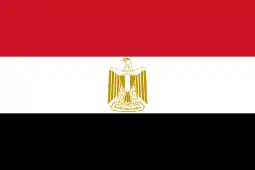 Port Said, Egypt (1962)
Port Said, Egypt (1962)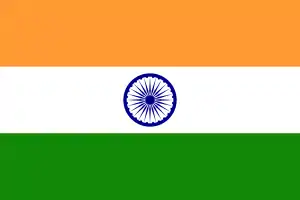 Chennai, India (1967)
Chennai, India (1967) Hiroshima, Japan (1972)
Hiroshima, Japan (1972) Cologne, Germany (1988)
Cologne, Germany (1988) Chemnitz, Germany (1988)
Chemnitz, Germany (1988) Cleveland, United States (1990)
Cleveland, United States (1990) Jilin City, China (1994)
Jilin City, China (1994)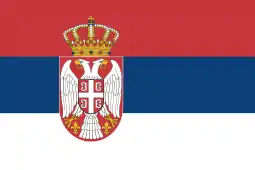 Kruševac, Serbia (1999)
Kruševac, Serbia (1999)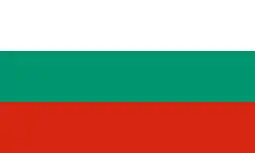 Ruse, Bulgaria (2001)
Ruse, Bulgaria (2001) İzmir, Turkey (2011)
İzmir, Turkey (2011) Chengdu, China (2011)
Chengdu, China (2011) Olevano Romano, Italy (2014)
Olevano Romano, Italy (2014) Ortona, Italy (2014)
Ortona, Italy (2014) Yerevan, Armenia (2015)
Yerevan, Armenia (2015)
- Several communities in France and Italy have streets or avenues named after Stalingrad, hence Place de Stalingrad in Paris and the eponymous Paris Métro station of Stalingrad.
References
Notes
- Charter of Volgograd, Preamble
- Official website of Volgograd. Конкурс на создание гимна Волгограда будет проведен повторно (in Russian)
- Law #139-OD
- Энциклопедия Города России. Moscow: Большая Российская Энциклопедия. 2003. pp. 81–83. ISBN 5-7107-7399-9.
- Charter of Volgograd, Article 22
- Russian Federal State Statistics Service (2011). "Всероссийская перепись населения 2010 года. Том 1" [2010 All-Russian Population Census, vol. 1]. Всероссийская перепись населения 2010 года [2010 All-Russia Population Census] (in Russian). Federal State Statistics Service.
- "26. Численность постоянного населения Российской Федерации по муниципальным образованиям на 1 января 2018 года". Federal State Statistics Service. Retrieved January 23, 2019.
- Law #1031-OD
- "Об исчислении времени". Официальный интернет-портал правовой информации (in Russian). June 3, 2011. Retrieved January 19, 2019.
- Почта России. Информационно-вычислительный центр ОАСУ РПО. (Russian Post). Поиск объектов почтовой связи (Postal Objects Search) (in Russian)
- "RUSSIA: Južnyj Federal'nyj Okrug: Southern Federal District". City Population.de. August 4, 2020. Retrieved October 18, 2020.
- Lutz-Auras, Ludmilla (2012). "Auf Stalin, Sieg Und Vaterland!": Politisierung Der Kollektiven Erinnerung an Den Zweiten Weltkrieg in Russland (in German). Springer-Verlag. p. 189. ISBN 978-3658008215.
- Mccauley, Martin (2013). Stalin and Stalinism (3 ed.). Routledge. ISBN 978-1317863687.
10 April 1925: Tsaritsyn is renamed Stalingrad.
- Brewer's Dictionary of 20th Century Phrase and Fable
- Grant, R. G. (2005). Battle: A Visual Journey Through 5,000 Years of Combat. Dorling Kindersley. ISBN 0-7566-1360-4.
- Wagner, Margaret; et al. (2007). The Library of Congress World War II Companion. Simon & Schuster. ISBN 978-0-7432-5219-5.
- Decision #72/2149
- "Russia revives Stalingrad city name". The Daily Telegraph. January 31, 2013. Retrieved February 7, 2013.
- "Stalingrad name to be revived for anniversaries". BBC News Online. February 1, 2013. Retrieved February 7, 2013.
- "Putin says Russian city Volgograd can become Stalingrad again". TASS.
- "Волгоград сдался выборам". www.gazeta.ru. 2012.
- Europa Publications (February 26, 2004). "Southern Federal Okrug". The Territories of the Russian Federation 2004. Taylor & Francis Group. p. 174. ISBN 9781857432480. Retrieved March 4, 2017.
The Oblast's administrative center is at Volgograd.
- Иванов открыл в Волгограде самый большой мост в Европе (in Russian). Vesti. Retrieved February 9, 2011.
- "Volgograd, Russia Köppen Climate Classification (Weatherbase)". Weatherbase. Retrieved November 13, 2018.
- "Average Weather in Volgograd, Russia, Year Round - Weather Spark". weatherspark.com. Retrieved May 23, 2019.
- "Pogoda.ru.net" (in Russian). Retrieved July 7, 2016.
- "Weatherbase: Historical Weather for Volgograd, Russia". Weatherbase. Retrieved November 17, 2012.
- "Volgograd State Technical University – Main page". Vstu.ru. August 21, 2011. Archived from the original on September 3, 2011. Retrieved September 15, 2011.
- Россия. "Волгоградский государственный медицинский университет (ВолгГМУ)". Volgmed.ru. Retrieved September 15, 2011.
- "Internet Archive Wayback Machine". June 27, 2007. Archived from the original on June 27, 2007. Retrieved September 15, 2011.
- "Города-побратимы". volgadmin.ru (in Russian). Volgograd. Retrieved February 1, 2020.
Sources
- Волгоградский городской Совет народных депутатов. Постановление №20/362 от 29 июня 2005 г. «Устав города-героя Волгограда», в ред. Решения №32/1000 от 15 июля 2015 г. «О внесении изменений и дополнений в Устав города-героя Волгограда». Вступил в силу 10 марта 2006 г. (за исключением отдельных положений). Опубликован: "Волгоградская газета", №7, 9 марта 2006 г. (Volgograd City Council of People's Deputies. Resolution #20/362 of June 29, 2005 Charter of the Hero City of Volgograd, as amended by the Decision #32/1000 of July 15, 2015 On Amending and Supplementing the Charter of the Hero City of Volgograd. Effective as of March 10, 2006 (with the exception of certain clauses).).
- Волгоградская областная Дума. Закон №139-ОД от 7 октября 1997 г. «Об административно-территориальном устройстве Волгоградской области», в ред. Закона №107-ОД от 10 июля 2015 г. «О внесении изменений в отдельные законодательные акты Волгоградской области в связи с приведением их в соответствие с Уставом Волгоградской области». Вступил в силу со дня официального опубликования. Опубликован: "Волгоградская правда", №207, 1 ноября 1997 г. (Volgograd Oblast Duma. Law #139-OD of October 7, 1997 On the Administrative-Territorial Structure of Volgograd Oblast, as amended by the Law #107-OD of July 10, 2015 On Amending Various Legislative Acts of Volgograd Oblast to Ensure Compliance with the Charter of Volgograd Oblast. Effective as of the day of the official publication.).
- Волгоградская областная Дума. Закон №1031-ОД от 21 марта 2005 г. «О наделении города-героя Волгограда статусом городского округа и установлении его границ», в ред. Закона №2013-ОД от 22 марта 2010 г «О внесении изменений в Закон Волгоградской области от 21 марта 2005 г. №1031-ОД "О наделении города-героя Волгограда статусом городского округа и установлении его границ"». Вступил в силу со дня официального опубликования (22 марта 2005 г.). Опубликован: "Волгоградская правда", №49, 22 марта 2005 г. (Volgograd Oblast Duma. Law #1031-OD of March 21, 2005 On Granting Urban Okrug Status to the Hero City of Volgograd and on Establishing Its Borders, as amended by the Law #2013-OD of March 22, 2010 On Amending the Law of Volgograd Oblast #1031-OD of March 21, 2005 "On Granting Urban Okrug Status to the Hero City of Volgograd and on Establishing Its Borders". Effective as of the day of the official publication (March 22, 2005).).
- Волгоградская городская Дума. Решение №72/2149 от 30 января 2013 г. «Об использовании наименования "город-герой Сталинград"», в ред. Решения №9/200 от 23 декабря 2013 г. «О внесении изменений в пункт 1 Порядка использования наименования "город-герой Сталинград", определённого Решением Волгоградской городской Думы от 30.01.2013 №72/2149 "Об использовании наименования "город-герой Сталинград"». Вступил в силу со дня принятия. Опубликован: "Городские вести. Царицын – Сталинград – Волгоград", #10, 2 февраля 2013 г. (Volgograd City Duma. Decision #72/2149 of January 30, 2013 On Using the Name of the "Hero City Stalingrad", as amended by the Decision #9/200 of December 23, 2013 On Amending Item 1 of the Procedures for Usage of the Name "Hero City Stalingrad", Adopted by the January 30, 2013 Decision #72/2149 of Volgograd City Duma "On Using the Name of the "Hero City Stalingrad". Effective as of the day of adoption.).
Bibliography
- See also: Bibliography of the history of Volgograd
External links
 Media related to Volgograd at Wikimedia Commons
Media related to Volgograd at Wikimedia Commons Volgograd travel guide from Wikivoyage
Volgograd travel guide from Wikivoyage- (in Russian) Official website of Volgograd
- (in Russian) Unofficial website of Volgograd
- Volgograd tourist information
- Sights of Volgograd
- (in German) Stalingrad – Bilder einer erbitterten Schlacht
- Volgograd State University
- . Encyclopædia Britannica (11th ed.). 1911.